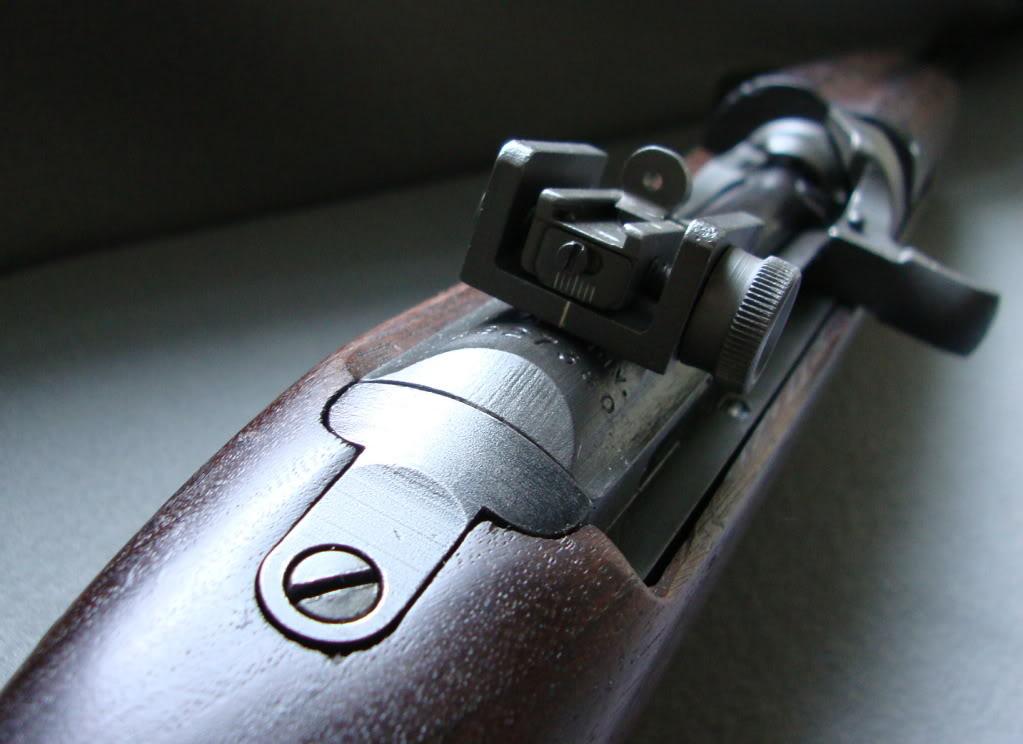That sight has been refinished, which really has nothing to do with its utility. What I said about targeting with a new rear sight is simply how it is done - you find by shooting where the sight base has to be in order to line up with the aperture centered and you then stake it in place. Then the windage knob gives you some adjustment capability either for actual wind or a change in ammo. But the aperture should be centered to start with and the sight based shifted as required to account for the peculiarities of that particular carbine. Obviously you would want to first make sure the barrel/front sight are properly installed and not rotated, and that the action is properly hung in the stock with no pressure in any direction exerted on the barrel by the barrel band when assembled. All you have to remember about the front sight is, you move it in the opposite direction of where you want to move the point of impact. When you move a front sight left, it forces you to swing the barrel to the right to aim at the target, which throws the shot to the right. On a carbine, which does not have any front sight adjustment, the barrel may not be indexed with the receiver. Look at the index marks to check. You have to remove the front sight to check this, but you do that and check the fit of the sight key in the barrel as well as the keyway in the sight base. The sight key may have to be replaced or peened. The sight should be a tight fit on the barrel which is why the correct tool is needed for removal/installation, to preserve the fit. A sight can be a tight fit on the barrel and still go on crooked if the indexing key is loose in the barrel or sight, which is why it has to be an exact fit. Frequently, on original carbines, we do not remove the front sight for any reason because it leaves tell-tale marks on the barrel in front of the sight. Even on a rebuild with good finish, removing the sight is usually not done as long as it is tight. So, most people would rather adjust the windage with the rear sight and not mess with the front sight at all. If the front sight blade is bent, you can try to straighten it but it could break off. In that case you have to replace it. The only adjustment possible on the front sight is the elevation. If the carbine shoots low, you shorten the sight blade to raise the POI. Once this is done, you're stuck with it so don't do this without due consideration of all factors, such as the ammo you're using.
The same thing was done with the original flip sight - the carbine would be fired, the sight moved one way or the other to correct windage, then it would be staked in place.
The early model adjustable sight (PI, HI), the presence ofthe small indexing plate on the rear of the sight proves that the sight base was adjusted in the dovetail to initially center the carbine on the target. The small amount of adjustment in the indexing plate then would allow the shooter to make small adjustments in the field to account for an ammo change, for example, then loosen the screw and shift the indexing plate back to the centerline of the sight base. If this were not the case, an aperture adjustment of more than a few clicks off-center would exceed the capacity of adjustment of the index plate.
Here is a properly installed sight base showing a slight field adjustment with the index plate re-centered.
 Information
Information

Warning: This is a relatively older thread
This discussion is older than 360 days. Some information contained in it may no longer be current.
- Knowledge Library

- MKL Entry of the Month
- Australia
- Austro-Hungarian Empire
- Canada
- Czechoslovakia
- Denmark
- Finland
- France/Belgium
- Germany
- Italy
- Japan
- Norway
- Russia
- South America
- Sweden
- Switzerland
- Turkey
- United Kingdom
- United States
- Yugoslavia
- Is my rifle authentic or a fake?
- Jay Currah's Lee Enfield Web Site
- On-line Service Records (Canada)
- Technical Articles/Research
- Forum
- Classifieds

- What's New?
-
Photo Gallery

- Photo Gallery Options
- Photo Gallery Home
- Search Photo Gallery List
-
Photo Gallery Search
- Video Club

- iTrader











 PM
PM
